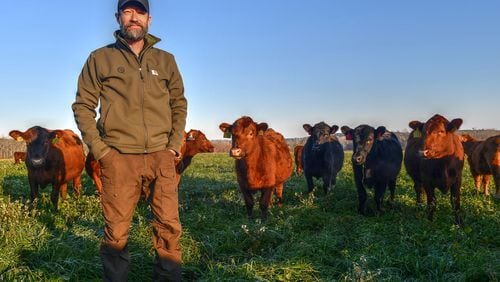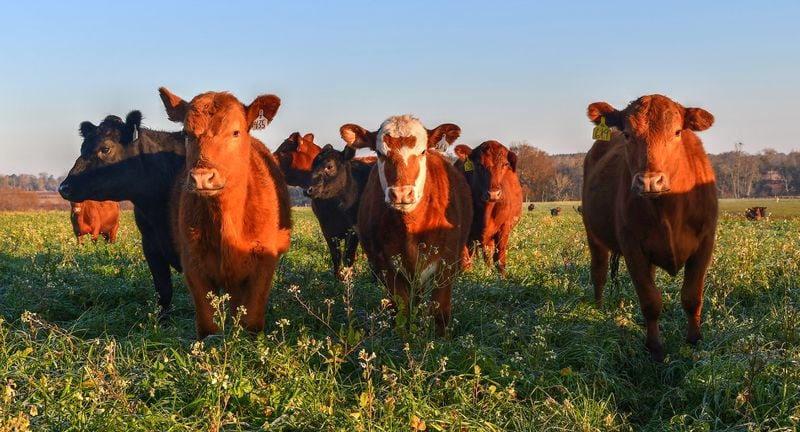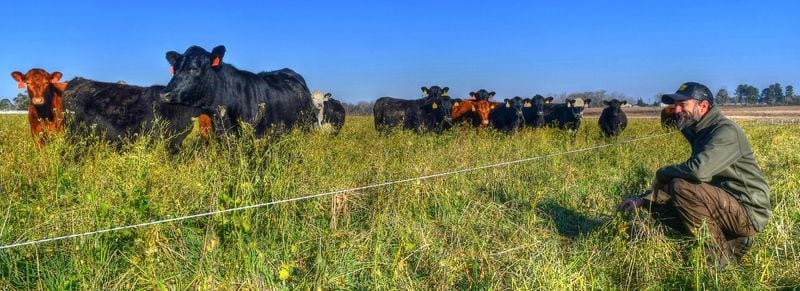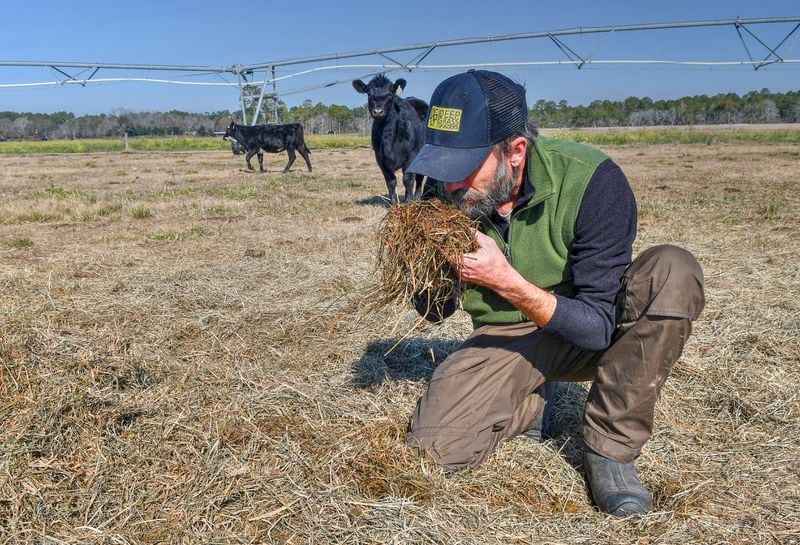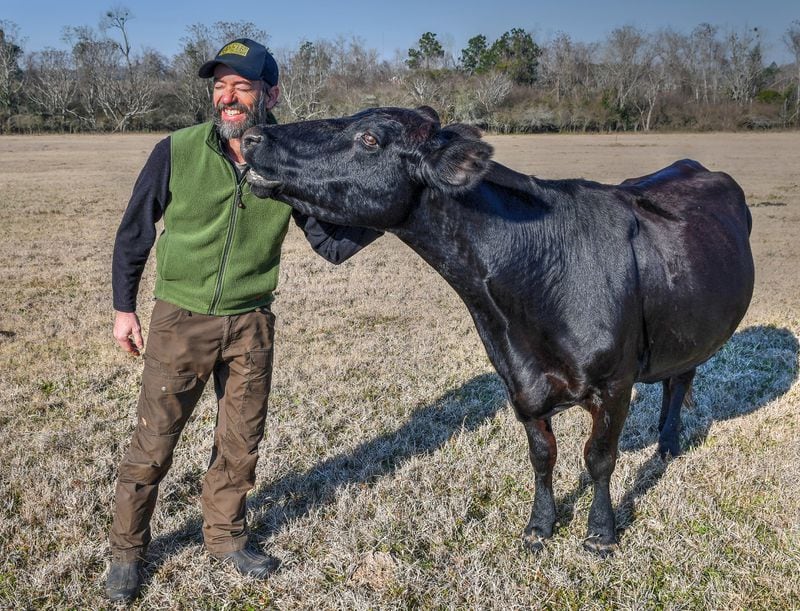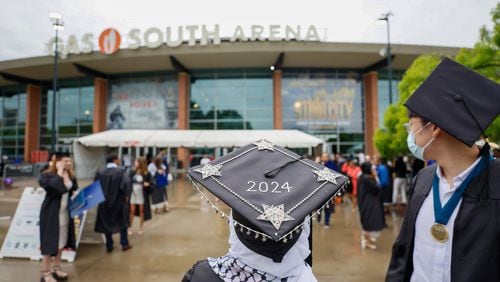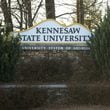FITZGERALD, Georgia — Watching a herd of cattle methodically moving through the pastureland at Deep Grass Graziers in southeast Georgia, you might not guess that the most important element of such an idyllic scene is hidden in plain sight.
“It’s all about the soil,” Dan Glenn will tell you, explaining that after he determined he would raise cows and market grass-finished beef, he suddenly realized he didn’t know what he didn’t know.
“I thought I just needed to learn whatever I could about cattle and I’d be successful,” he said. “Then I realized, no, I need to be a good forage manager. And the more I learned about forage, I recognized it was about the soil. If we get the soil healthy, we can grow healthy forages and in turn have healthy cows, and a healthy beef product.”
Essentially, Glenn is practicing regenerative agriculture that, in opposition to factory farming and feed lots, aims to support animal health by allowing cows and other ruminants to graze naturally on a variety of forages, including grass and other plants, rather than feeding them corn or other grains.
Glenn grew up in Osierfield, a tiny community northeast of Tifton where four generations of his family owned and farmed the land around Irwin and Ben Hill counties. As the only grandchild, he spent summers working on his grandfather’s farms, where peanuts, corn and cotton grew, along with cattle.
Back then, he wasn’t attracted to farming. “I was always reading a book,” Glenn said. “I knew one day I would have the opportunity or responsibility to manage or direct things. But I didn’t have any interest in studying agriculture or animal husbandry.”
Credit: CHRIS HUNT
Credit: CHRIS HUNT
Instead, he studied English and journalism at the University of Georgia and planned to be a magazine writer. But after five years and two degrees, Glenn switched gears to spend time in the culinary world and “write for fun.” For a time he worked at the Grit in Athens, then joined a friend to start a catering business.
In 2002, Glenn moved to St. Croix, where he helped found the Virgin Islands Sustainable Farm Institute, a working farm centered around research, education and local food production and distribution. That’s where he met his wife, Jennifer, who was teaching at the university.
Coming home
With a growing interest in the Slow Food movement, the couple moved back to Georgia in 2009. Thinking he would open a farm-to-table restaurant, Glenn bought a 100-year-old building in downtown Osierfield that was once a small country store. The restaurant never got off the ground, but during that time he decided to try his hand at becoming a cattleman.
“I realized our cow program was suffering, so I stepped in to start looking after our cattle,” Glenn said. “That’s when I went down the rabbit hole to really enjoying being around the cattle. And then I had to figure out what my role and my ethos would be putting my stamp on the program.”
Taking over what he called “a very conventional cattle program,” with large-framed, heavily-muscled calves that excelled in feed lots, Glenn transitioned the operation to raising grass-finished cows. That means, they never eat corn or other grains.
In the process, allowing cows to graze naturally increases soil biodiversity and is better for the environment in terms of how animal waste is dealt with. Plus, there’s emerging belief that grass-fed beef is better for human health.
But first, Glenn had to change the type of cows he raised.
“I got interested in grass-finishing from a soil health perspective, and a human health perspective and an environmental perspective,” Glenn said “I realized those type of genetics didn’t work for what I wanted to do. They got too big, and it was really hard to get a proper finish on them, where they’re going to marble and taste good.”
Nowadays, his herds are mostly from British breed bloodlines, such as Red Angus, Black Angus and Hereford, which can fatten on grass more efficiently than many other breeds. And recently, Glenn started saving some of his own bulls, rather than selling them off.
“When you can start saving bulls off of your best cows that are the highest performing in your environment, then you’re speeding up the adaptability of that offspring faster,” he said. “My goal now is to identify my top producing cows, save the best bulls off of them and breed them back to the herd.”
Credit: CHRIS HUNT
Credit: CHRIS HUNT
The pivot
Another Deep Grass Graziers innovation is the center pivot irrigation system Glenn installed. “There aren’t many people who take a pivot built for row crops and make it a permanent grazing pasture, and that’s what we’ve done here,” he said.
As the name suggests, the grazing pivot is set up with sprinklers attached to steel outriggers that are moved around a 90-acre field. The pie-shaped parcel is subdivided into multiple paddocks by a series of fences, with water troughs positioned on the fence lines so the cows can reach them between two paddocks.
“The key to grass finishing is having a high-quality forage year-round,” Glenn said. “Hybrid Bermuda grass for summer, polyculture plantings in late spring and fall and two pastures for tillage in November and December. Doing managed grazing, we’re utilizing manure and urine in an efficient way to act as fertilizer. We’re also utilizing our hay feeding in ways that feed the ground as well.”
Currently, the family owns some 3,000 acres and rents another 350 acres. But of that, as much as 1,000 acres is covered with trees and swamps. “Between row crops and pasture, it’s more like 1,900 acres,” Glenn said.
Glenn describes the day-to-day job as “labor intensive,” working with multiple breeding groups, multiple blood lines, developing bulls and selling females. “I’ve managed to make breeding cattle as complicated as possible,” he said, laughing.
Credit: CHRIS HUNT
Credit: CHRIS HUNT
Cow pies and baleage
Over the years, Glenn has become involved in multiple scientific and regenerative agriculture organizations, including the American Forage and Grassland Council, the National Grazing Lands Coalition and the USDA’s Sustainable Agriculture Research and Education program. But in addition to science and data, there are times when his eyes and nose can be just as useful.
With herds of different types, ages and nutritional needs, a cattle farmer often needs to act as a dietitian. And one of the best ways to determine the quality of the forage and the health of the cattle is by observing their manure.
“The best cow pies look like pancake batter, are almost symmetrical and even have a divot in the middle,” Glenn instructed. “That’s the perfect patty. What you don’t want is a tall pie that looks like horse manure. It has too much fiber in it.”
While Deep Grass Graziers cows aren’t fed grains, they do get the likes of turnips, collards and kale. Plus there’s baleage, a partially dried forage, similar to hay, that’s baled and wrapped in plastic. And Glenn has developed a keen sense of when baleage is healthy for his cattle to consume by visually inspecting for certain molds.
Credit: CHRIS HUNT
Credit: CHRIS HUNT
The bigger picture
Spending time on the farm with Glenn, it’s obvious he loves and cares for his cows and the land they live on. And he has favorite cows who reciprocate those feelings, including a Black Angus that regularly nuzzles him as a morning greeting. As one of his mentors, Will Harris of White Oak Pastures, is wont to say, he tries to make sure they only have one bad day.
But as the percentage of vegetarians and vegans in the U.S. continues to grow, meat and the way it’s produced continues to create cultural and moral divisions.
“It’s easy to feel reticent about supporting the modern American confined animal operation system,” Glenn said. “I have no problem with someone having a moral distaste for that. Is it the cheapest way to produce low-price protein? Yes. But is that the system we want to support?”
As a guiding tenet of regenerative agriculture, Glenn sees a future where beef production is not only ethical, but radically improves the environment.
“A properly managed farm or ranch can improve the landscape over time and improve the water holding capacities of our soils, the amount of biological material you can grow on a given acre over time and mimic the natural cycles that have occurred for tens of thousands of years,” he said. “Right now we’re on the cusp of the science measuring those things.”
For more information about Deep Grass Graziers, visit deepgrassgraziers.com. Find more stories about Georgia farmers and recipes for their products at ajc.com/georgia-on-my-plate.
About the Author
